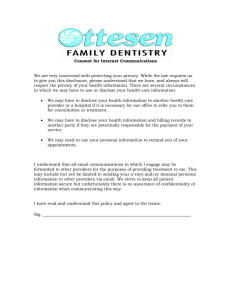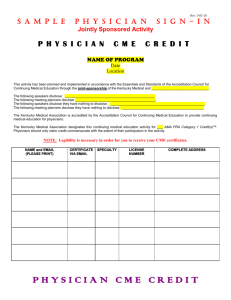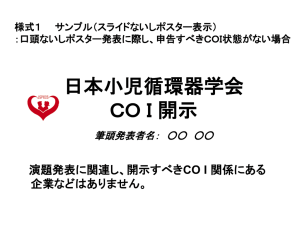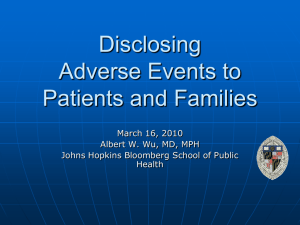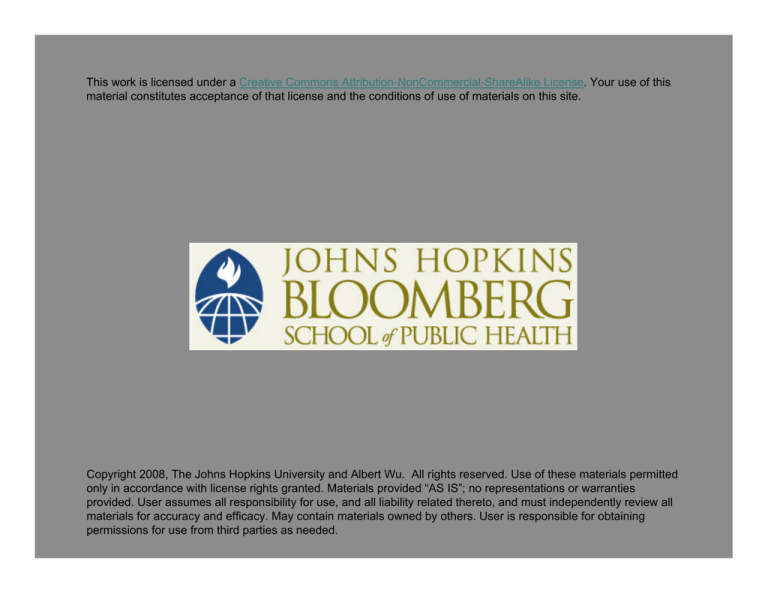
This work is licensed under a Creative Commons Attribution-NonCommercial-ShareAlike License. Your use of this
material constitutes acceptance of that license and the conditions of use of materials on this site.
Copyright 2008, The Johns Hopkins University and Albert Wu. All rights reserved. Use of these materials permitted
only in accordance with license rights granted. Materials provided “AS IS”; no representations or warranties
provided. User assumes all responsibility for use, and all liability related thereto, and must independently review all
materials for accuracy and efficacy. May contain materials owned by others. User is responsible for obtaining
permissions for use from third parties as needed.
Disclosure of Adverse Events and Medical Errors
Albert W. Wu, MD, MPH
Section A
Why Disclose?
Case
Sixty-five-year-old woman transferred from cardiac intensive
care where she had been admitted for acute myocardial
infarction and congestive heart failure
4
Case Study
Rapidly progressive increasing dyspnea
Cardiac team returns, administers 100% O2 via face mask
Cardiology fellow calls for 2 mg morphine sulfate “IV push”
5
Case Study
Or, directs medical student to “push this”
Medical student administers 10 mg of intravenous morphine
sulfate
6
Case Study
Respiratory rates slows from 32 to 2
7
Case Study
Respiratory rate slows from 32 to 2
Patient intubated
Returns to cardiac intensive care
8
Flashbulb Memories
Vivid, persistent memories of especially important events, like
the JFK assassination, or the events of 9/11, that are usually
charged with emotion
9
Everyone Makes Mistakes
All practicing clinicians make mistakes
10
Responses to Mistakes
Horror, fear
Remorse
Anger
Guilt
Isolation, no place to hide
Doubt, feelings of incompetence
11
Lawyers, Professional Organizations, and Ethicists Agree
The occurrence of the error must be disclosed to the patient
and/or family member
12
Why Disclose?
Ethical duty to disclose
“Physicians should disclose to patients information about
procedural and judgment errors made in the course of care, if
such information significantly affects the care of the patient.”
— 1992 American College of Physicians’ Ethics Manual
13
Why Disclose?
Ethical duty to disclose
JCAHO
“Patients and, when appropriate, their families, are informed
about the outcomes of care, including unanticipated
outcomes.”
— JCAHO Standard RI.1.1.2, July 1, 2001
14
Why Disclose?
Ethical duty to disclose
JCAHO
Institutional policy
15
JHH Interdisciplinary Practice Manual: Error Disclosure
Philosophy: The Johns Hopkins Hospital (JHH) strives for safety in patient care,
teaching, and research
Policy
All health care professionals have an obligation to report medical errors as a
means to improve patient care delivery and to help promote safety and
quality in patient care.
Since the majority of medical errors can be linked to environmental and
systems-related issues that may affect the actions of health professionals, a
systems improvement focus will be used in all error analysis.
Prompt reporting of a medical error in good faith will not result in punitive
action by the hospital against the involved individuals except as mandated
by law or regulatory requirements. The principles concerning non-punitive
reporting do not eliminate the hospital’s obligations to conduct ongoing and
periodic performance review, where repeated errors or other issues may lead
to personnel action.
It is the right of the patient to receive information about clinically relevant
medical errors. The JHH has an obligation to disclose information regarding
these errors to the patient in a prompt, clear, and honest manner. This is
consistent with The Johns Hopkins Hospital Code of Ethics.
Definition of medical error: An act or omission with potential or actual negative
consequences for a patient that, based on standard of care, is considered to be an
incorrect course of action.
16
If You Don’t Know How, You’ll Avoid It
If you know how to do something, your threshold to do it
goes down
“Why didn’t
you tell the
patient?”
“I didn’t
know what
to say.”
17
House Officer Survey
Anonymous survey about worst mistake
Serious adverse outcome 90%, death 31%
24% told patient and/or family
Source: Wu et al. (1991). Do house officers learn from their mistakes? JAMA, 265, 2089.
18
For Patients, Failure to Disclose Adds Insult to Injury
“Why is it that when things go wrong, everyone clams up?”
— Lucian Leape on behalf of an anonymous patient
19
Summary
Mistakes are inevitable
We are obligated to disclose mistakes to patients and their
family members
More training and experience is needed
20
Section B
How to Disclose
What?
Any incident which causes harm to the patient or which
requires a change in their care
22
When?
As soon as possible after the incident is recognized
Update the patient or family when more information is
learned
23
Who?
Attending physician
In conjunction with other caregivers
X Physician in training
X Nurse
X Administrative representative?
24
Where?
The physician’s office
A room off the waiting room
The most important thing—
Ensure privacy for the patient/family
25
What Patients Want
The facts
Responsibility taken
Actions to prevent the same event happening to others
An apology
Notes Available
26
What to Disclose
As much as you know up to the time of the disclosure
Disclosure is part of an ongoing dialog between patient and
physician
27
What to Say?
Treat it as an instance of “breaking bad news”
28
A Good Reference
Source: Buckman, Robert, and Kason, Yvonne. (1992). How to break bad news: A guide for health care professionals. Baltimore: Johns
Hopkins University Press.
29
What to Say?
Begin by stating you regret to say that you have made a
mistake
Describe the course of events, using non-technical language
30
What to Say (cont.)
State the nature of the mistake, consequences, and corrective
action
Express personal regret and apologize
Elicit questions or concerns and address them
Plan the next step
31
Planning and Following Through
Make a list of the patient’s top priorities
Devise and explain a plan to address them
Identify the patient’s coping/support mechanism
Plan the next contact—this is just the initial conversation
32
Section C
Case Examples
Chemotherapy Overdose
Mr. Smith, a healthy 71-year-old, has chemotherapy after
successful surgery for early colon cancer
Hospitalized two days later with multi-organ failure
Physician discovers she miscalculated chemo dose, resulting
in a 10x overdose
Discloses adverse event to patient’s son
34
Chemotherapy Overdose
Mr. Smith, a healthy 71-year-old, has chemotherapy after
successful surgery for early colon cancer
Hospitalized two days later with multi-organ failure
Physician discovers she miscalculated chemo dose, resulting
in a 10x overdose
Discloses adverse event to patient’s son
35
Chemotherapy Overdose: Responsibility Accepted
At this point in the
presentation, you will view an
online video that that will
appear in another browser
window.
Follow Steps 1 and 2, below, to
view the video and then return
to this lecture.
Click to Play
36
The Overlooked Mammogram
Ms. Merrill is a 45-year-old woman visiting her doctor for an
annual physical
One year ago she complained of a painless breast lump
Dr. Rubach ordered a mammogram
Ms. Merrill never received the results
37
The Overlooked Mammogram (cont.)
Dr. Rubach reviews chart before the physical and notes
results are not in the folder
Results on the computer from a year ago show a 2 cm lesion
with high probability of malignancy
Dr. Rubach begins the disclosure to Ms. Merrill in her office
38
Apologizing
“Anything you say can be used against you”
39
Wall Street Journal, May 18, 2004
40
“I’m Sorry” . . . “I Am Guilty”
Make an appropriate apology
In the case of system failure or no obvious fault—
“I am so sorry that this happened”
In the case of personal responsibility—
“I am sorry that I did this”
41
Responsibility
In general, responsibility for the error should be accepted on
behalf of the health care team and the institution
Those involved with the care should not be personally
named, blamed, or criticized
42
Managing Your Own Emotions
Avoid
Anger
Defensiveness
Detachment
43
The Disclosure Process
Recognition of incident
Harm
No harm
(Discretionary)
Act to mitigate
harm
Continuing
patient care
Investigate/contact risk
management
Notify
patient/family
Continue
investigation/improve
safety
Continue dialogue
with patient/family
44
Removing Insult from Injury
For information on obtaining the video, go to:
www.jhsph.edu/removinginsultfrominjury
45

